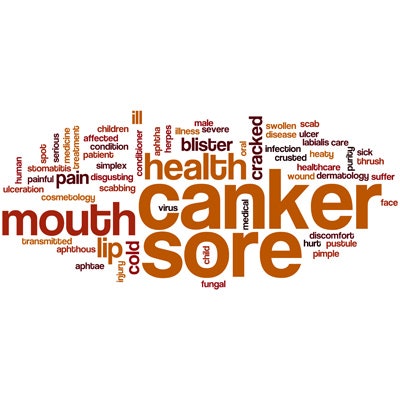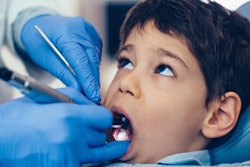
Are there any ways to prevent minor recurrent aphthous stomatitis, also known as canker sores, in your pediatric patients? Do hygiene habits, practitioner preventive protocols, or psychosocial factors contribute to its occurrence? A new study examined these relationships.
Researchers performed intraoral exams on children between the ages 5 and 12 and also interviewed them and administered a questionnaire to the study participants. They found associations between minor recurrent aphthous stomatitis and caries, as indicated by both the presence of decayed teeth and a score of greater than 0 on the decayed, missing, and filled teeth (DMFT) index.
"This outcome gave us a further confirmation that caries in the active phase (teeth decayed, not the filled teeth), rather than the presence of filled teeth in itself, seem to predispose to the appearance of recurrent aphthous," wrote the study authors, led by Simona Tecco, DDS, PhD, an associate professor at the dental school of Vita-Salute San Raffaele University in Milan, Italy (BMC Pediatrics, April 13, 2018).
Caries connection
Minor recurrent aphthous stomatitis involves the occurrence of multiple, painful, small, round ulcers and is hard to prevent. Its etiology remains unclear, although previous studies suggest there may be a connection to allergies, trauma, genetic predisposition, endocrine disorders, stress and anxiety, and microbiota in the mouth.
Consideration of psychosocial factors also is important because oral health conditions affect the quality of life in young patients, and parents can underestimate the effects of poor oral health on their children, the authors wrote.
For these reasons, the researchers designed a study to examine the role of various clinical and psychosocial factors in the occurrence of canker sores in children to help oral health practitioners identify useful prevention strategies. They investigated associations between oral aphthosis and behavioral indexes of psychosocial attitudes, habits, oral hygiene practices, lifestyle, systemic diseases, and oral health.
The study included 401 schoolchildren who were 5 to 12 years old and used data collected during a celiac disease prevention project by dentists, hygienists, and dental students from Milan's San Raffaele Hospital, which is part of the university.
“This outcome gave us a further confirmation that caries in the active phase, rather than the presence of filled teeth in itself, seem to predispose to the appearance of recurrent aphthous.”
After obtaining parental consent, the researchers conducted intraoral exams in each child and collected data on the following:
- Enamel hypoplasia
- Enamel hypoplasia of incisors
- Enamel hypoplasia of molars
- Decayed teeth
- Filled teeth
- Decayed, missing, and filled teeth
- Presence of sealed fissures
They asked participants if they brushed their teeth when not at home, whether their teeth ached, and if they received help and instruction in toothbrushing. They also asked study participants about the following additional factors:
- Ownership of a personal tablet, as an indicator of socioeconomic status and family wealth
- Snack habits and types of snacks frequently consumed at school
- Food intolerance
- Celiac disease diagnosis
- Regular sports activities
- Topical fluoride treatments received
The investigators found that 14 of the children had minor recurrent aphthous stomatitis, and they classified the remaining 387 as controls.
They found a significant association between the presence of decayed teeth and minor recurrent aphthous stomatitis (p = 0.039), with the risk of decayed teeth 3.15 times higher in these children than in controls. The investigators also reported a significant association between having a DMFT index greater than 0 and minor recurrent aphthous stomatitis (p = 0.029), with this being 3.3 times higher than in controls.
| Oral health factors in controls & cases of minor recurrent aphthous stomatitis | ||
| No. of controls (%) | No. of cases (%) | |
| Presence of decayed teeth | 74/387 (19.2%) | 6/14 (42.9%) |
| DMFT index score of 1 or greater | 89/387 (23.2%) | 7/14 (50%) |
The researchers reported the following additional statistically significant relationships:
- Brushing teeth when not at home and a comparatively lower DMFT index (p = 0.011)
- Receiving assistance from parents with oral hygiene at home and a comparatively reduced presence of decayed teeth (p = 0.038)
- Reported severity of sensed dental pain and the presence of decayed teeth (p = 0.011)
- Reported severity of sensed dental pain and oral health condition as expressed by the DMFT index (p = 0.043)
They found no associations between lifestyle, social status, or presence of systemic diseases and clinical or psychological indexes. The investigators also reported no statistical association between ulcers and filled teeth.
"This outcome gave us a further confirmation that caries in the active phase (teeth decayed, not the filled teeth), rather than the presence of filled teeth in itself, seem to predispose to the appearance of recurrent aphthous," they wrote.
Limitations of school
The authors noted the following limitations of their study:
- Oral exams were conducted at school and not in dental chairs.
- Use of the questionnaire may have made it difficult to receive sincere and accurate answers from children.
The authors recommended additional research on clinical and psychosocial factors related to the link between recurrent aphthous stomatitis and oral hygiene, as well as on practices for dentists to follow in children with this condition.
"Closer attention should be paid to the evaluation of potential carious lesions, by implementing protocols of prevention to control recurrent aphthous stomatitis disease in children affected by caries, while considering the manifold attitude-related psychosocial indexes, markers, and predictors of children's oral care and, ultimately, oral status and health," they concluded.



















